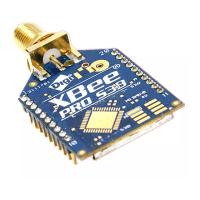SPI operation SPI signals
XBee®-PRO 900HP/XSC RF Modules
42
The device transmits and receives data with the most significant bit first using SPI mode 0. This
means the CPOL and CPHA are both 0. We chose Mode 0 because it is the typical default for most
microcontrollers and simplifies configuring the master.
SPI signals
The specification for SPI includes the four signals: SPI_MISO, SPI_MOSI, SPI_CLK, and SPI_SSEL. Using
only these four signals, the master cannot know when the slave needs to send and the SPI slave
cannot transmit unless enabled by the master. For this reason, the SPI_ATTN signal is available. This
allows the device to alert the SPI master that it has data to send. In turn, the SPI master asserts SPI_
SSEL and starts SPI_CLK unless these signals are already asserted and active respectively. This allows
the XBee-PRO 900HP RF Module to send data to the master.
The following table names the SPI signals and specifies their pinouts. It also describes the operation
of each pin.
Signal name
Pin
number
Applicable
AT
command Description
SPI_MISO
(Master In, Slave
out)
4 P2 When SPI_SSEL is asserted (low) and SPI_CLK is active,
the device outputs the data on this line at the SPI_CLK
rate. When SPI_SSEL is de-asserted (high), this output
should be tri-stated such that another slave device can
drive the line.
SPI_MOSI
(Masterout,Slave
in)
11 D4 The SPI master outputs data on this line at the SPI_CLK
rate after it selects the desired slave. When the device is
configured for SPI operations, this pin is an input.
SPI_SSEL
(Slave Select)
(Master out, Slave
in)
17 D3 The SPI master outputs a low signal on this line to
select the desired slave. When the device is configured
for SPI operations, this pin is an input.
SPI_CLK
(Clock)
(Master out, Slave
in)
18 D2 The SPI master outputs a clock on this pin, and the rate
must not exceed the maximum allowed, 3.5 Mb/s. When
you configure the device for SPI operations, this pin is an
input.
SPI_ATTN
(Attention)
(Master in, Slave
out)
19 D1 The device asserts this pin low when it has data to send
to the SPI master. When this pin is configured for SPI
operations, it is an output (not tri-stated).
Note By default, the inputs have pull-up resistors enabled. See PR (Pull-up/Down Resistor Enable) to
disable the pull-up resistors. When the SPI pins are not connected but the pins are configured for SPI
operation, the pull-ups are required for proper UART operation.
Full duplex operation
SPI on the XBee-PRO 900HP RF Module requires that you use API mode (without escaping) to
packetize data. By design, SPI is a full duplex protocol even when data is only available in one

